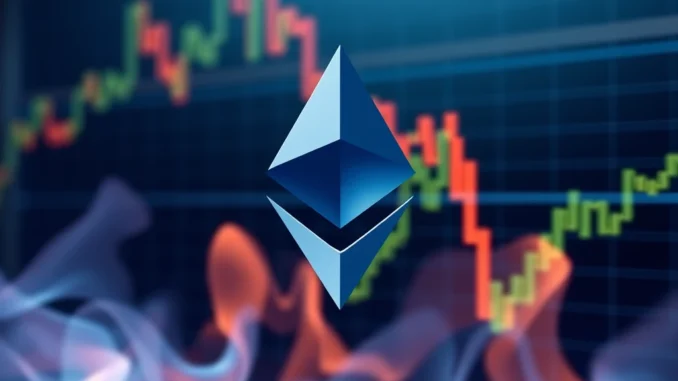
Is Ethereum’s (ETH) price truly reflecting its actual utility? A thought-provoking analysis from on-chain expert Checkmate suggests a significant shift in how we should value ETH. According to Checkmate, Ethereum’s price is undergoing a crucial adjustment, aligning more closely with its real-world gas consumption. This revelation could reshape how investors perceive ETH’s market value and the broader smart contract blockchain ecosystem. Let’s dive deep into this fascinating perspective and understand what it means for the future of Ethereum and layer-1 blockchains.
Decoding Ethereum’s Price Adjustment to Real Gas Consumption
Checkmate, a respected on-chain analyst, recently took to X (formerly Twitter) to share his insightful take on Ethereum’s current market dynamics. His core argument revolves around the idea that Ethereum’s price is recalibrating to mirror its fundamental utility as a ‘gas token.’ But what does this exactly mean, and why is it significant for anyone invested in or following the crypto space?
To understand this, we first need to grasp the concept of ‘gas’ in the Ethereum network. Gas is essentially the fee required to conduct transactions or execute smart contracts on the Ethereum blockchain. It’s the fuel that keeps the Ethereum engine running. Now, Checkmate points out a crucial discrepancy:
- Investor Holdings vs. Actual Gas Needs: Most ETH holders possess far more ETH than they practically need for covering transaction fees. In fact, he estimates that many investors hold 10 to 100 times the amount of ETH required for their actual gas consumption.
- The Misconception of Gas Demand and Price: There’s a prevalent belief in the crypto community that increased gas demand automatically translates to a higher ETH price and market capitalization. Checkmate challenges this notion, suggesting it might be a flawed assumption.
- A Layer-1 Blockchain Issue: This isn’t just an Ethereum-specific problem. Checkmate emphasizes that this potential misalignment between perceived value and real utility extends to all smart contract layer-1 blockchains.
In essence, Checkmate is suggesting that the market might be overvaluing ETH (and potentially other layer-1 tokens) based on a simplistic understanding of gas demand driving price. He proposes a more nuanced view where the ETH price should be more accurately reflecting the actual gas consumption on the network – the real utility it provides.
Why is Real Gas Consumption a Critical Metric for ETH Price?
Why should we focus on real gas consumption when evaluating Ethereum’s price? The answer lies in understanding the fundamental value proposition of ETH. While ETH serves multiple purposes, including staking and governance, its primary utility within the Ethereum ecosystem is as gas. If the price of ETH is detached from its core function as gas, it raises questions about the sustainability of its valuation.
Consider these points:
- Fundamental Utility: For any asset to maintain long-term value, its price should, to some extent, be anchored to its fundamental utility. In Ethereum’s case, gas consumption represents a direct measure of network usage and demand for its core services.
- Market Speculation vs. Real-World Usage: If ETH’s price is primarily driven by speculation and future expectations, rather than current, tangible network usage (reflected in gas consumption), it might be more susceptible to market volatility and corrections.
- Sustainability of Network Value: A healthy and sustainable blockchain ecosystem needs a balance between token price and actual network activity. If the price is inflated without corresponding real gas consumption, it could lead to an unsustainable bubble.
By focusing on real gas consumption, analysts and investors can gain a more grounded perspective on Ethereum’s intrinsic value, potentially filtering out some of the noise and hype that often surrounds the crypto market.
Challenging the Narrative: Does Higher Gas Demand Always Mean Higher ETH Price?
The traditional crypto narrative often suggests a direct correlation: higher gas demand equals higher ETH price. Checkmate challenges this assumption, and it’s crucial to understand why this linear relationship might not always hold true.
Let’s break down the complexities:
| Factor | Traditional View | Checkmate’s Perspective |
|---|---|---|
| Gas Demand Increase | Directly drives up ETH price due to increased network activity and token utility. | While increased activity is positive, the price increase might not be directly proportional or sustainable if it outpaces real-world usage. |
| Investor Behavior | Investors buy and hold ETH expecting future gas demand to push prices higher. | Many investors hold excessive ETH relative to their actual gas needs, suggesting speculative holdings rather than utility-driven demand. |
| Market Cap Calculation | Market cap is often seen as directly linked to network utility and gas demand. | Market cap might be inflated if it’s not accurately reflecting the actual economic activity and gas consumption on the network. |
| Layer-1 Blockchains | High gas fees on layer-1s are often seen as a sign of success and value accrual to the native token. | Excessive gas fees might deter users and developers in the long run, and the token price should reflect a sustainable balance between network usage and cost. |
Checkmate’s analysis encourages a more critical look at the drivers of ETH price. While gas demand is undoubtedly important, it’s essential to differentiate between:
- Speculative Gas Demand: Driven by hype, short-term trends, or artificial activity.
- Real Gas Consumption: Reflecting genuine, long-term utility and economic activity on the network.
A healthy ETH price appreciation should ideally be supported by a robust and growing real gas consumption, indicating genuine network adoption and utility.
Beyond Ethereum: A Layer-1 Blockchain Dilemma?
Checkmate’s point about this issue not being unique to Ethereum is particularly noteworthy. It raises a broader question about the valuation models of all smart contract layer-1 blockchains. If the premise holds true for ETH, it likely extends to other platforms like Solana, Avalanche, Cardano, and others that rely on native tokens for gas fees.
This perspective suggests a potential industry-wide re-evaluation might be necessary. Investors and analysts might need to shift their focus from simply tracking transaction counts or total value locked (TVL) to more granular metrics that reflect real gas consumption and network utility.
Questions to consider for layer-1 blockchains:
- What percentage of token holders are actually using the network for transactions and smart contracts?
- How does the token price correlate with actual gas consumption versus speculative trading volume?
- Are current valuation models accurately reflecting the sustainable utility of these platforms?
- Could a focus on real gas consumption lead to more realistic and less volatile market valuations for layer-1 tokens?
Actionable Insights: Navigating the Ethereum Market with a Real Gas Consumption Lens
So, what are the actionable takeaways from Checkmate’s analysis? For investors and participants in the Ethereum ecosystem, adopting a real gas consumption lens can offer several benefits:
- Informed Investment Decisions: By monitoring gas consumption metrics, investors can gain a deeper understanding of the actual demand for Ethereum’s utility, leading to more informed investment decisions.
- Risk Assessment: Understanding the relationship between ETH price and real gas consumption can help assess potential risks and identify periods where the price might be detached from fundamental utility.
- Long-Term Perspective: Focusing on real utility encourages a long-term investment perspective, grounded in the sustainable growth and adoption of the Ethereum network.
- Critical Analysis of Layer-1s: This framework can be applied to analyze other layer-1 blockchains, enabling a more consistent and utility-focused approach to evaluating their potential.
While speculative fervor will always play a role in crypto markets, a deeper understanding of real gas consumption can provide a more solid foundation for evaluating the true value and potential of Ethereum and other smart contract platforms.
In Conclusion: A Critical Reassessment of Ethereum’s Value
Checkmate’s analysis serves as a critical reminder to look beyond surface-level metrics and delve into the fundamental drivers of value in the crypto space. The idea that Ethereum’s price is adjusting to real gas consumption is not just a technical observation; it’s a call for a more mature and utility-focused approach to valuing blockchain networks.
By emphasizing the importance of real gas consumption, Checkmate encourages a shift from purely speculative valuation models to those grounded in actual network usage and economic activity. This perspective, if widely adopted, could lead to a more sustainable and resilient crypto market, where token prices are more closely aligned with the tangible utility and value these networks provide. As the crypto landscape evolves, such insightful analyses become increasingly vital for navigating the complexities and making informed decisions in this dynamic space.



